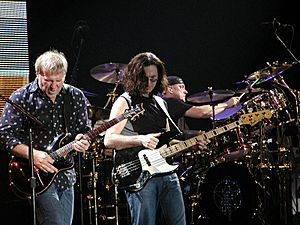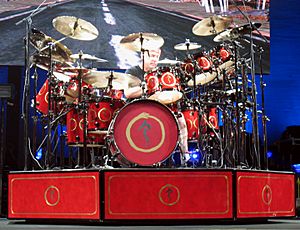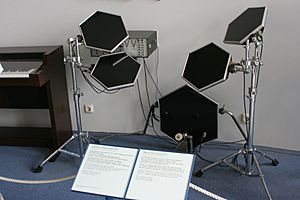Neil Peart facts for kids
Quick facts for kids
Neil Peart
|
|
|---|---|

Peart performing in 2008
|
|
| Background information | |
| Birth name | Neil Ellwood Peart |
| Also known as | The Professor, Bubba, Pratt |
| Born | September 12, 1952 Hamilton, Ontario, Canada |
| Died | January 7, 2020 (aged 67) Santa Monica, California, U.S. |
| Genres | |
| Occupation(s) |
|
| Instruments |
|
| Years active | 1968–2020 |
| Labels | |
Neil Ellwood Peart was a Canadian-American musician. He was best known as the drummer and main songwriter for the rock band Rush. Fans often called him 'The Professor'. He was famous for his amazing drumming skills and powerful live shows.
Neil Peart was born in Hamilton, Ontario, Canada, in 1952. He grew up in Port Dalhousie. As a teenager, he played in many local bands. He wanted to become a full-time drummer. After trying to make it in England, he came back home. In 1974, he joined Rush, a band from Toronto.
With Rush, Neil released 19 studio albums. Ten of these albums sold over a million copies in the United States. Billboard magazine even listed Rush as third for having the most consecutive gold or platinum albums by a rock band.
Early in his career, Neil's drumming style was based on hard rock. He was inspired by drummers like Keith Moon and John Bonham. Later, he started to learn from jazz and big band drummers like Gene Krupa and Buddy Rich. In 1994, Neil worked with jazz teacher Freddie Gruber. This helped him change his playing style to include more jazz and swing elements.
Besides drumming, Neil was Rush's main lyricist. His lyrics explored many topics, including science fiction, fantasy, and philosophy. He also wrote seven non-fiction books about his travels and life stories. He even co-wrote fantasy novels based on Rush's album Clockwork Angels.
Neil announced he was stopping touring in 2015. In 2018, his bandmate Alex Lifeson said Rush had stopped playing together. This was partly due to Neil's health. Neil Peart passed away on January 7, 2020, at age 67, after a long illness. He lived in Santa Monica, California, with his wife and daughter.
Contents
Biography
Early Life and Music Beginnings
Neil Peart was born on September 12, 1952. He was the first of four children. His family lived on a farm in Hagersville, Ontario, near Hamilton. When he was two, his family moved to St. Catharines. Neil described his childhood as happy.
As a young teenager, he became interested in music. He listened to popular music on his transistor radio. His first music lessons were on the piano, but he said they didn't help him much. He loved drumming on things with chopsticks. For his 13th birthday, his parents bought him drum sticks and a practice drum. They promised him a full drum kit if he kept practicing for a year.
He got his first drum kit for his 14th birthday. He started taking lessons. His first public performance was at a school Christmas show. He later played with his first band, The Eternal Triangle, at his high school. He even performed his first drum solo there.
Neil worked at Lakeside Park in Port Dalhousie. This park later inspired a song on Rush's album Caress of Steel. By his late teens, Neil played in local bands like Mumblin' Sumpthin' and the Majority. They played at church halls, schools, and skating rinks across Southern Ontario.
Starting a Music Career
At 18, Neil went to London, England. He hoped to become a professional drummer there. He played in some bands and did occasional studio work. To support himself, he sold jewelry at a shop on Carnaby Street.
While in London, he read books by Ayn Rand. Her ideas about individualism were very inspiring to him. You can see her influence in his early lyrics, like "Anthem" and "2112".
After 18 months, Neil felt he wasn't making enough progress. He decided to put his dream on hold and returned to Canada. Back in St. Catharines, he worked for his father, selling tractor parts.
Joining the Band Rush
After returning to Canada, Neil joined a local band called Hush. Soon after, he was asked to try out for Rush. Rush needed a new drummer because their original drummer, John Rutsey, had left. Geddy Lee and Alex Lifeson were the band members who watched him audition.
Neil arrived in shorts, driving an old car, with his drums in trashcans. He thought the audition was a disaster. But Geddy Lee and Neil connected over their shared love for books and music. Alex Lifeson wasn't as sure at first.
After talking it over, Neil officially joined Rush on July 29, 1974. This was just two weeks before the band's first US tour. Neil played his first show with Rush on August 14, 1974. They opened for other bands in front of over 11,000 people in Pittsburgh.
Neil quickly became the band's main lyricist. He had written songs before joining Rush. Since the other members weren't very interested in writing lyrics, Neil's writing skills became very important. The band worked hard and toured a lot.
Their first album with Neil, Fly by Night (1975), was successful. But their next album, Caress of Steel, was not well-received. In response, Neil wrote the song "2112" for their next album, also called 2112 (1976). This album became their big breakthrough. It helped them gain many fans in the United States.
The tour for 2112 ended with three shows in Toronto. Neil had always dreamed of playing at this venue. During these shows, Geddy Lee introduced him as "The Professor on the drum kit."
Rush recorded five studio albums in four years and played up to 300 shows a year. This busy schedule made the band decide to slow down later. Neil described this early period as "a dark tunnel."
Changing His Drumming Style
In 1991, Neil was asked to play at a special concert in New York City. It was a tribute to the famous jazz drummer Buddy Rich. Neil agreed and played with the Buddy Rich Big Band for the first time. He felt his performance wasn't his best. To improve, he later produced two tribute albums called Burning for Buddy: A Tribute to the Music of Buddy Rich.
While working on the first tribute album, Neil noticed how much another drummer, Steve Smith, had improved. He asked Steve his "secret." Steve said he had been studying with drum teacher Freddie Gruber. Neil then decided to take lessons from Freddie Gruber himself. This helped him change his drumming style. He started adding more jazz and swing elements to his playing.
In 2007, Neil played at another Buddy Rich tribute concert. He took more lessons to improve his swing style. He performed at the concert in New York in 2008.
Personal Challenges and Return to Music
In 1997, after a Rush tour, Neil's 19-year-old daughter, Selena, died in a car crash. Less than a year later, his wife of 23 years, Jacqueline, died from cancer.
In his book Ghost Rider: Travels on the Healing Road, Neil wrote that he told his bandmates he was retiring. Neil took a long break to grieve and think. He traveled extensively across North and Central America on his motorcycle. He rode for about 88,000 kilometers (55,000 miles). His book tells the story of this journey.
After his travels, Neil returned to the band. He met photographer Carrie Nuttall in Los Angeles. They got married in 2000. In 2001, Neil told his bandmates he was ready to make music again. Their new album, Vapor Trails, came out in 2002.
During the tour for Vapor Trails, the band decided Neil would not do daily press interviews. This was to protect him from having to talk about the sad events in his life. After Vapor Trails, Neil continued as a full-time musician. In 2009, Neil and Carrie had their first child, a daughter named Olivia Louise.
In the mid-2010s, Neil became a citizen of the United States.
Retirement and Passing
Neil announced his retirement from touring in 2015. He had been dealing with chronic tendinitis and shoulder problems. In 2018, Alex Lifeson confirmed that Rush was "basically done." Neil remained friends with his former bandmates.
Neil Peart passed away on January 7, 2020, in Santa Monica, California. He died from glioblastoma, a serious form of brain cancer. He had been diagnosed three and a half years earlier. His illness was kept private until his death. His family announced his passing on January 10. Fans and musicians around the world were very sad to hear the news.
Musicianship
Drumming Style and Inspirations
Neil Peart's drumming skills were highly respected by fans, other musicians, and music journalists. He had many different inspirations. These included rock drummers like John Bonham and Keith Moon. He also learned from fusion and jazz drummers like Billy Cobham and Buddy Rich. The band The Who was the first group that made him want to write songs and play drums.
Neil used to play with a matched grip. But in the mid-1990s, he changed to a traditional grip while learning from jazz teacher Freddie Gruber. He used the traditional grip in his instructional DVD A Work in Progress. Later, he mostly went back to matched grip. However, he would still use traditional grip for certain songs or parts of his drum solos. He explained these choices in his DVD Anatomy of a Drum Solo.
Variety magazine wrote that Neil was "widely considered one of the most innovative drummers in rock history." They noted his large drum kits, precise playing, and exciting stage presence. USA Today compared him to other top rock drummers like John Bonham and Keith Moon. He was inducted into the Modern Drummer Hall of Fame in 1983 for his technical skills.
Music critic Amanda Petrusich wrote in The New Yorker: "Watching Peart play the drums gave the impression that he might possess several phantom limbs. The sound was merciless."
Drumming Equipment
Over the years, Neil played drums from different brands, including Slingerland, Tama, Ludwig, and Drum Workshop. He used Zildjian and Wuhan cymbals for many years. In the early 2000s, he switched to Sabian Paragon cymbals, which were made specially for him.
Starting in 1984, Neil used a complex 360-degree drum kit during concerts. This kit could rotate as he played different parts of it.
In the late 1970s, he added many different percussion instruments to his acoustic drum kit. These included orchestra bells, tubular bells, and timpani. From the mid-1980s, he started using MIDI trigger pads. These allowed him to play sounds sampled from many different instruments. This saved space on stage. He also used electronic sounds.
Neil also added a rotating drum riser to his kit. During live shows, this riser would turn. This allowed him to switch between his acoustic drums and his electronic drums. A famous part of his drum solos was when the kit would rotate during the solo. This showed a change in his drumming style within the solo.
In the early 2000s, Neil used new electronic drum technology, like Roland V-Drums. He also continued to use samplers with his acoustic drums. His collection of sampled sounds grew over the years.
Neil also designed his own signature drumsticks with Pro-Mark. They were called Promark PW747W Neil Peart Signature drumsticks.
Drum Solos
Neil was famous for his unique drum solos during concerts. These solos often included unusual percussion instruments. They featured long, complex sections with unusual time signatures. His solos were so complex that his upper and lower body movements sometimes seemed completely separate. A common part of his solos was a repeating pattern he called "The Waltz."
His drum solos were on every live album Rush released. On earlier albums, the solo was part of a song. Later, it became a separate track. His instructional DVD Anatomy of a Drum Solo (2005) shows how he created his solos. He explained how he made them musical, not just showing off.
Lyricism
Neil Peart was the main lyricist for Rush. His writing was greatly influenced by books. In his early days with Rush, his lyrics were inspired by fantasy, science fiction, and philosophy.
After 1980, with the album Permanent Waves, Neil stopped using fantasy themes as much. The album Moving Pictures (1981) still had heroic figures, but they were in a more modern setting. The song "Limelight" on that album was about Neil's own feelings about being famous. From Permanent Waves onwards, most of Neil's lyrics focused on social and emotional topics. He often used metaphors and symbols.
The album Grace Under Pressure (1984) touched on serious topics like the the Holocaust ("Red Sector A") and the death of friends ("Afterimage"). In later albums, Neil continued to explore many different lyrical ideas. He even wrote about love and relationships, a topic he had avoided before. The album Vapor Trails (2002) was very personal for Neil. It also covered topics like the 9/11 terrorist attacks. The album Snakes & Arrows (2007) mostly dealt with Neil's thoughts on faith and religion.
The song "2112" is about a person fighting against a totalitarian (controlling) government. This song helped the band become famous. But it also brought some criticism because Neil thanked Ayn Rand in the album notes. Some critics called the band "Junior fascists." Neil was surprised by this reaction.
Neil later clarified his connection to Ayn Rand's philosophy. He said, "I am no one's disciple." He also wrote about his religious views, saying, "I'm a linear thinking agnostic, but not an atheist." An agnostic is someone who isn't sure if God exists.
While some critics didn't like his lyrics, Allmusic called him "one of rock's most accomplished lyricists."
Political Views
For most of his career, Neil Peart did not publicly say which political party he supported. However, his political and philosophical ideas were often seen in his work with Rush.
He was sometimes thought to be an "Objectivist" and an admirer of Ayn Rand. This was mainly because of his early work with Rush, especially the album 2112. However, in 1994, Neil said he was not a strict Objectivist. He said that while the "individual is paramount in matters of justice and liberty," he was not a follower of anyone's ideas. In a 2012 interview, he said Rand's ideas were important to him 40 years ago, but not anymore.
Even though some thought he was a "Conservative" or "Republican" rock star, he criticized the US Republican Party. He said their ideas were "absolutely opposed to Christ's teachings." In 2005, he described himself as a "left-leaning libertarian." A libertarian believes in a lot of personal freedom and limited government.
In a 2015 interview, Neil said he saw the US Democratic Party as the better choice for someone with his beliefs.
Neil was also a member of the Canadian charity Artists Against Racism. He worked with them on a public service announcement.
Side Projects and Appearances
Neil Peart also played drums on albums for other artists:
- He played on two songs for Jeff Berlin's 1985 album Champion.
- He played drums on songs for Vertical Horizon's albums Burning the Days (2009) and Echoes from the Underground (2013). He also co-wrote a song on Burning the Days.
- He produced and played on two tribute albums for Buddy Rich, called Burning for Buddy: A Tribute to the Music of Buddy Rich (1994) and Burning for Buddy: A Tribute to the Music of Buddy Rich, Vol. 2 (1997).
Neil had small appearances in a few films:
- A brief cameo in the 2007 film Aqua Teen Hunger Force Colon Movie Film for Theaters.
- A short appearance in the 2008 film Adventures of Power.
- He appeared in concert with Rush in the 2009 film I Love You, Man. He also appeared in a funny web short for Funny or Die related to the film.
DVDs
Besides Rush's band videos, Neil Peart released several instructional DVDs:
- A Work in Progress
- Anatomy of a Drum Solo (2005)
- The Making of Burning for Buddy
- Taking Center Stage: A Lifetime of Live Performance (2011)
- Fire on Ice: The Making of the Hockey Theme (2011)
Awards and Honours
Neil Peart received many awards from Modern Drummer magazine's reader's poll:
- Hall of Fame: 1983 (He was the youngest person ever to be honored this way.)
- Best Rock Drummer: He won this award many times (1980, 1981, 1982, 1983, 1984, 1985, 1986, 2006, 2008).
- Best Multi-Percussionist: 1983, 1984, 1985, 1986.
- Best Instructional Video: 2006, for Anatomy of a Drum Solo.
- Best Drum Recording of the 1980s: 2007, for "YYZ".
- He won "Best Recorded Performance" for many Rush albums from 1980 to 2012.
He also received awards from DRUM! magazine:
- Drummer of the Year: 2007, 2008, 2009, 2010.
- Best Progressive Rock Drummer: 2007, 2009.
- Best Live Performer: 2007.
- Best DVD: 2007, for Anatomy Of A Drum Solo.
- Best Drumming Album: 2007, for Snakes & Arrows.
Other important honors and awards:
- Neil was made an Officer of the Order of Canada in 1996, along with Geddy Lee and Alex Lifeson. Rush was the first rock band to receive this honor as a group.
- He was inducted into the Canadian Songwriters Hall of Fame in 2010.
- Rush was inducted into the Rock and Roll Hall of Fame in 2013.
- In 2020, the city council of St. Catharines named a pavilion in Lakeside Park after Neil Peart.
- Neil was inducted into the Percussive Arts Society Hall of Fame in 2020.
Additional Reading
- Rhythm & Light, photos of Peart by Carrie Nuttall (2004)
- Taking Center Stage: A Lifetime of Live Performance by Joe Bergamini (2013)
See also
 In Spanish: Neil Peart para niños
In Spanish: Neil Peart para niños




